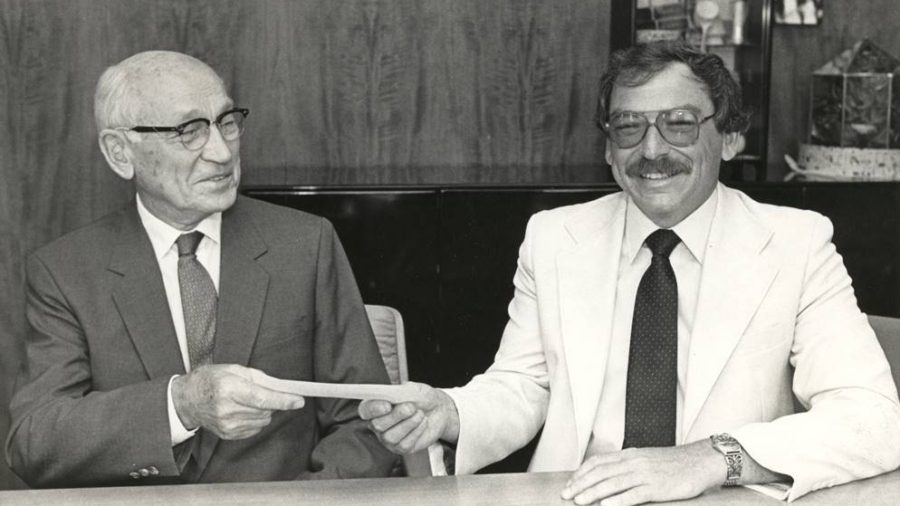Remembering Michael Berns
Inspired by a ruby beam of light, the Beckman Laser Institute co-founder changed science, medicine – and UCI
Biomedical laser pioneer Michael Berns, who co-founded and directed UCI’s storied Beckman Laser Institute & Medical Clinic, died Saturday, Aug. 13. He was 79.
Renowned for his groundbreaking work using “laser scissors and tweezers” to manipulate cells, among other innovations, Berns was also a painter, avocado farmer and spy thriller novelist.
“He was way ahead of his time,” said the Beckman lab’s current director, Thomas Milner, who described Berns as “creative, tenacious, complex and kind.”
Born in December 1942 in Burlington, Vermont, Berns originally dreamed of being a veterinarian. He detoured into lasers while studying biology at Cornell University.
“It was 1966 and all I knew about lasers was that Goldfinger was going to slice James Bond in half,” he wrote for a conference presentation that was to be delivered later this month in San Diego. “Then one of my professors at Cornell told me that the department had purchased a small ruby laser but did not know what to do with it.”
Berns figured out an answer – and then some.
After finishing his Ph.D. in 1968, he became the first person to perform subcellular surgery of chromosomes, helped pioneer laser nanosurgery and eventually earned the nickname “the father of laser microbeams,” according to SPIE, the international society for optics and photonics, which awarded Berns its gold medal this year for his lifetime achievements.
In 1972, after teaching zoology at the University of Michigan, he joined UCI’s Department of Developmental and Cell Biology, which he later chaired, and enchanted students. “His class was so much fun,” said Sari Mahon, who first studied under Berns in 1974 and now serves as assistant director of the Beckman Laser Institute. “He was an incredibly dedicated mentor and teacher.”
His signature accomplishment – the Beckman Laser Institute & Medical Clinic – began taking shape in 1979, when Berns won an NIH grant to set up the Laser Microbeam Program, better known as LAMP, at UCI.
“After spending a year building the LAMP system — an instrument with a tunable wavelength laser microbeam and a wide range of energies and exposure durations — Berns sent out invitations to every CEO of medical and biotech companies in Orange County,” according to SPIE. “To his surprise, Arnold Beckman (then 80 years old and still running Beckman Instruments in Fullerton)” showed up at the lab on a rainy morning.
Beckman, an influential scientist and businessman whose 1934 invention of the pH meter launched his company, was transfixed by LAMP’s potential.
His subsequent investment in “a young professor, an unproven university, and an emerging technology” – as one history put it – led to the institute’s debut in 1986, with Berns as the lab’s founding director – and its heart and soul.
Even today, nearly two decades after Berns stepped down from running the center, it’s difficult to separate the man from the institute, Milner said.
The walls are decorated with his paintings and the building itself bears his imprint, said Elliot Botvinick, a UCI professor of surgery and biomedical engineering who did his postdoctoral work under Berns: “The architectural design speaks to Michael’s ability to look decades into the future. The building was one of just a few in the world combining a medical clinic with basic molecular biology, biophotonics and engineering, all along the same hallway. His vision was to have technologies invented in laboratories, matured and ultimately brought to the clinic. … Many of the technologies were commercialized.”
Scientists came from around the world for a residency at the institute, Botvinick added. And, in turn, Berns traveled the globe sharing his expertise.
On one trip, to the Soviet Union in 1979 to deliver lectures on laser biomedicine at Moscow State University, he was interrogated by KGB agents for 12 hours after being caught smuggling Jewish prayer books inside a false-bottomed suitcase. (He carried the contraband as a favor to student activists at UCI.) The incident later inspired a character in his 2021 spy novel, The Tinderbox Plot.
“As a longtime fan of thrillers, I imagined these interrogators reporting to a boss like Karla in John le Carré’s novel, Smiley’s People,” he recently wrote. “After the Jewish bible bust, I was never allowed to return to the Soviet Union, but my interest in the culture, politics and people in Russia never abated. Nor did my fascination with spy novels, and eventually, I decided to write one.”
But lasers remain his crowning legacy. Berns’ scientific achievements, which are too legion to catalog, were “highly impactful and did not slow throughout his career,” Botvinick noted. “His work has been cited over 26,000 times, spanning the fields of developmental biology, DNA repair, mechanobiology, the cytoskeleton, fertility, preservation of endangered species, and immunology, to just name a few.”
In 1994, he received the UCI Medal, the university’s highest honor.
Berns, who retired in 2020 as the Arnold and Mabel Beckman Professor at UCI (he also was an adjunct professor of bioengineering at UC San Diego), is survived by his son, Gregory, a dog psychology expert, M.D. and Distinguished Professor of neuroeconomics at Emory University; his daughter, Tammy Karn, an English professor at Mt. San Antonio College; and two granddaughters.
Read more on UCI News.



